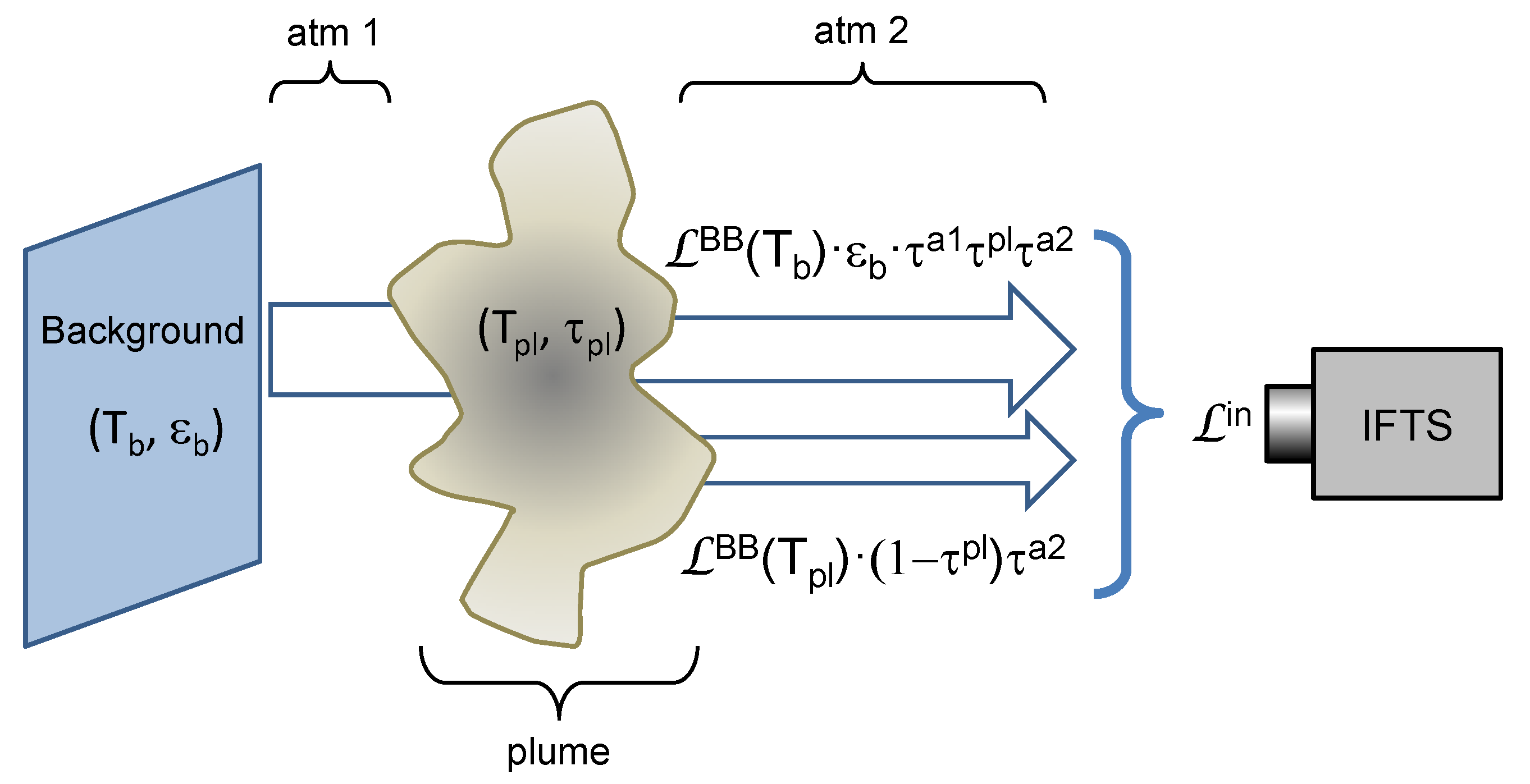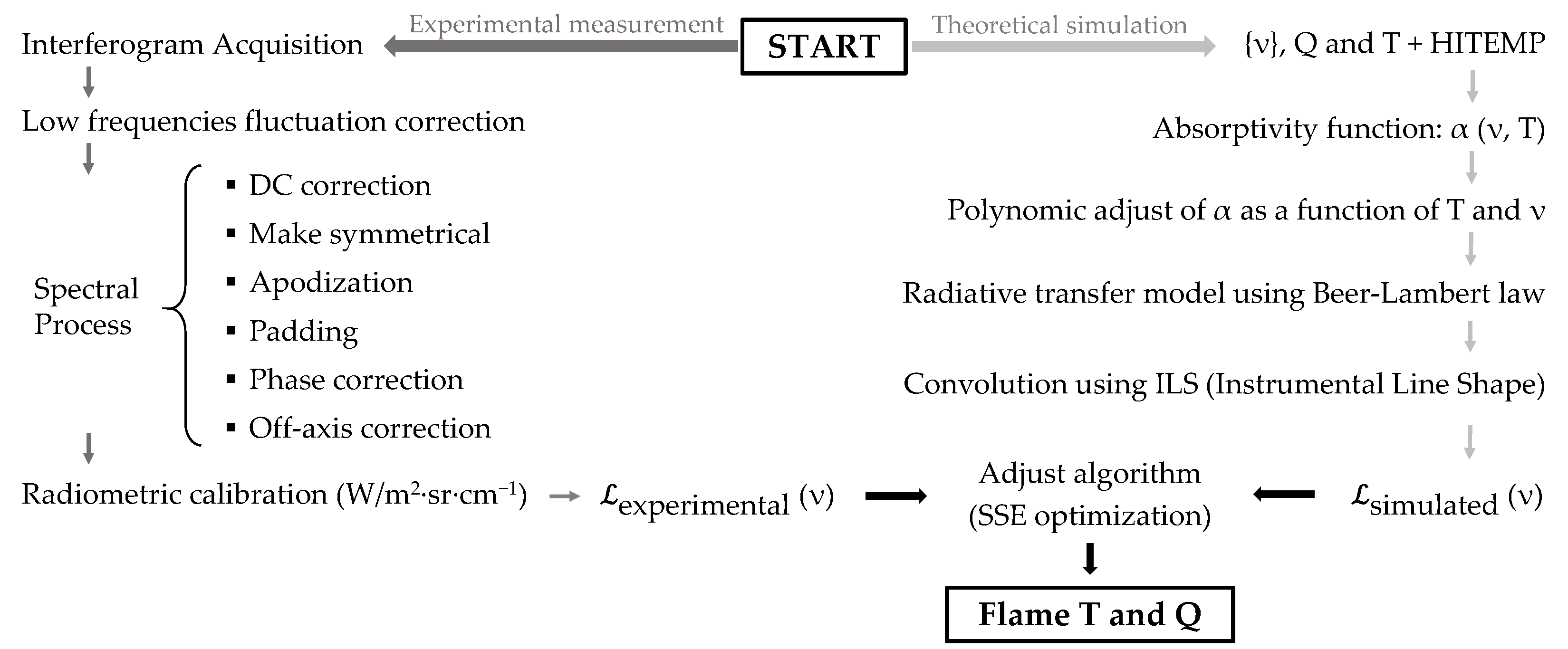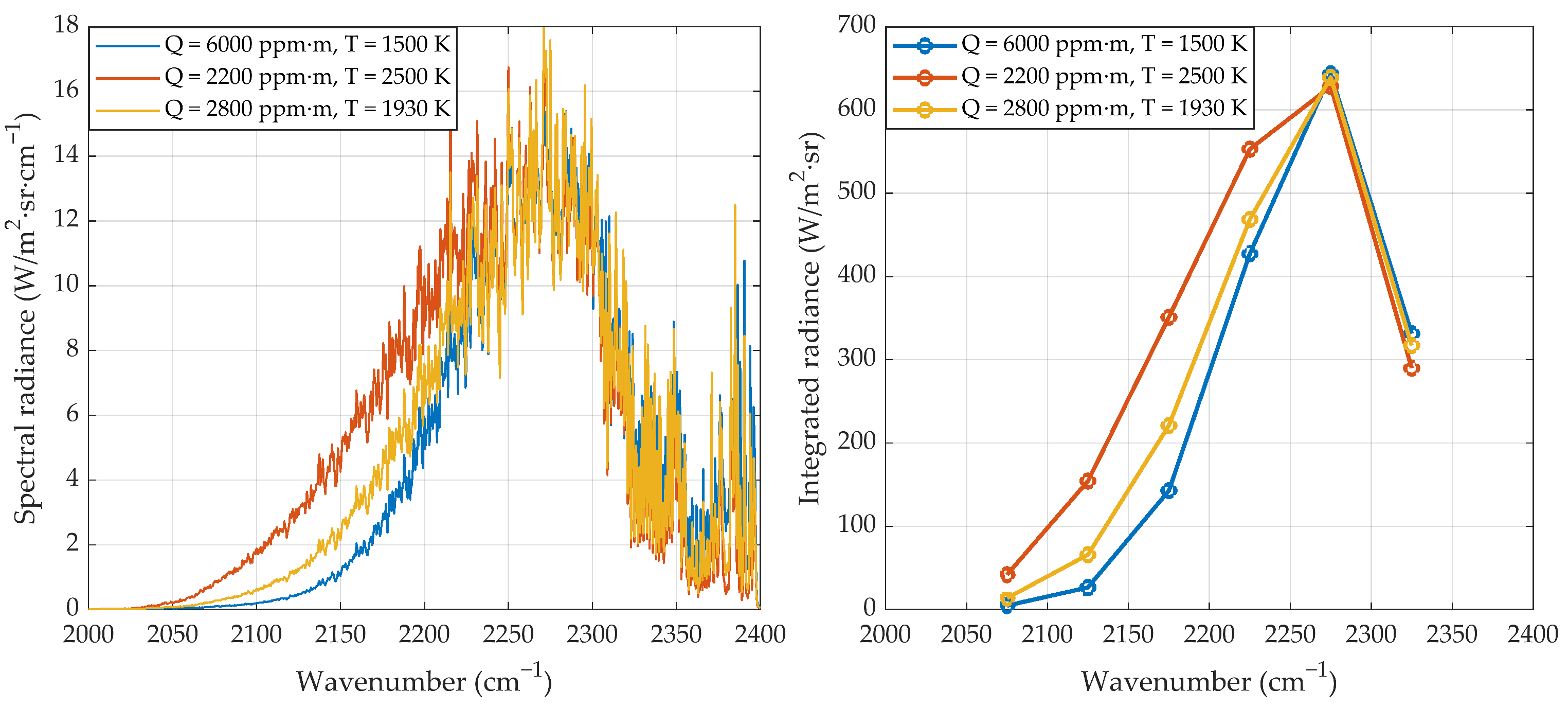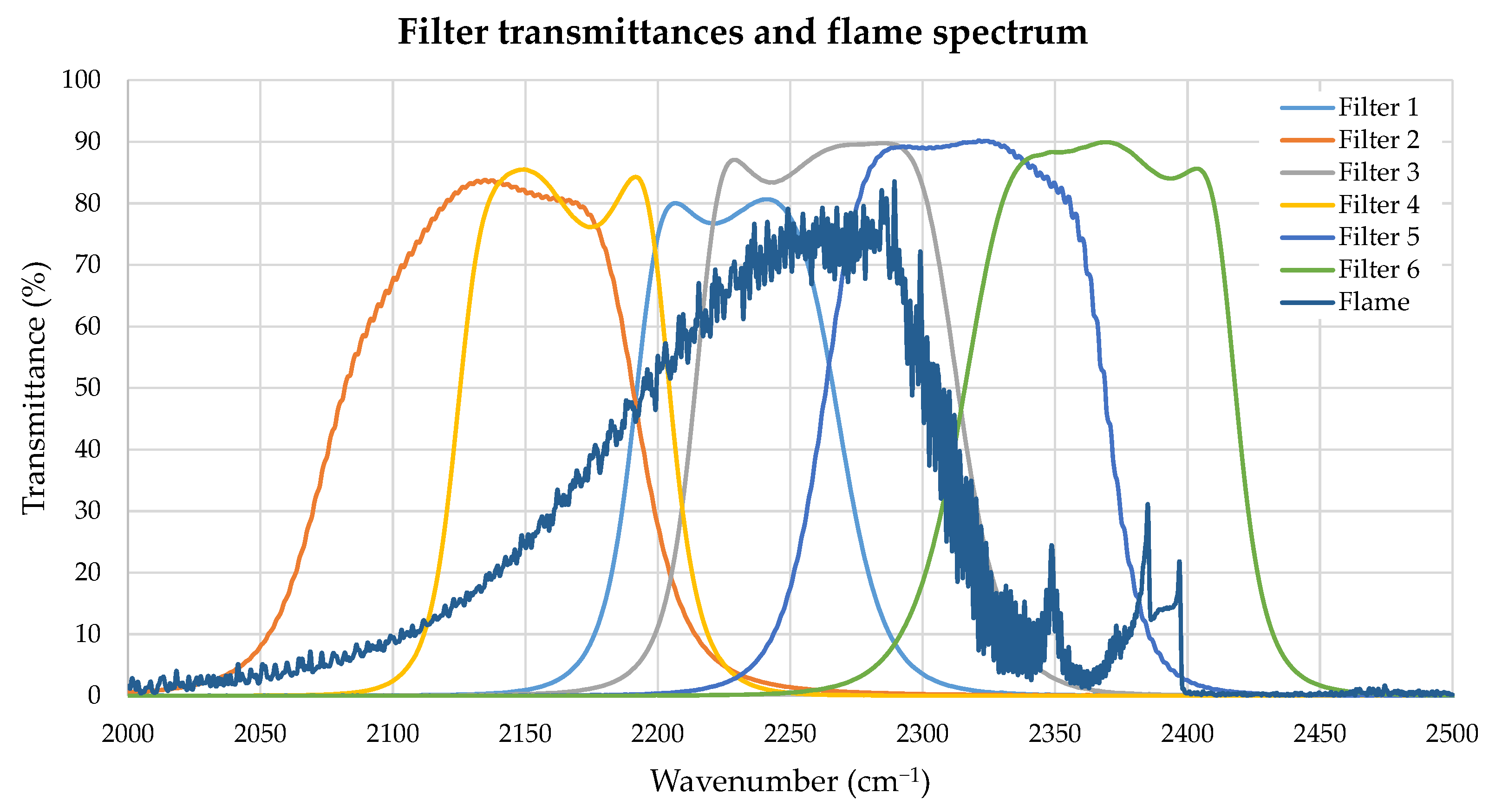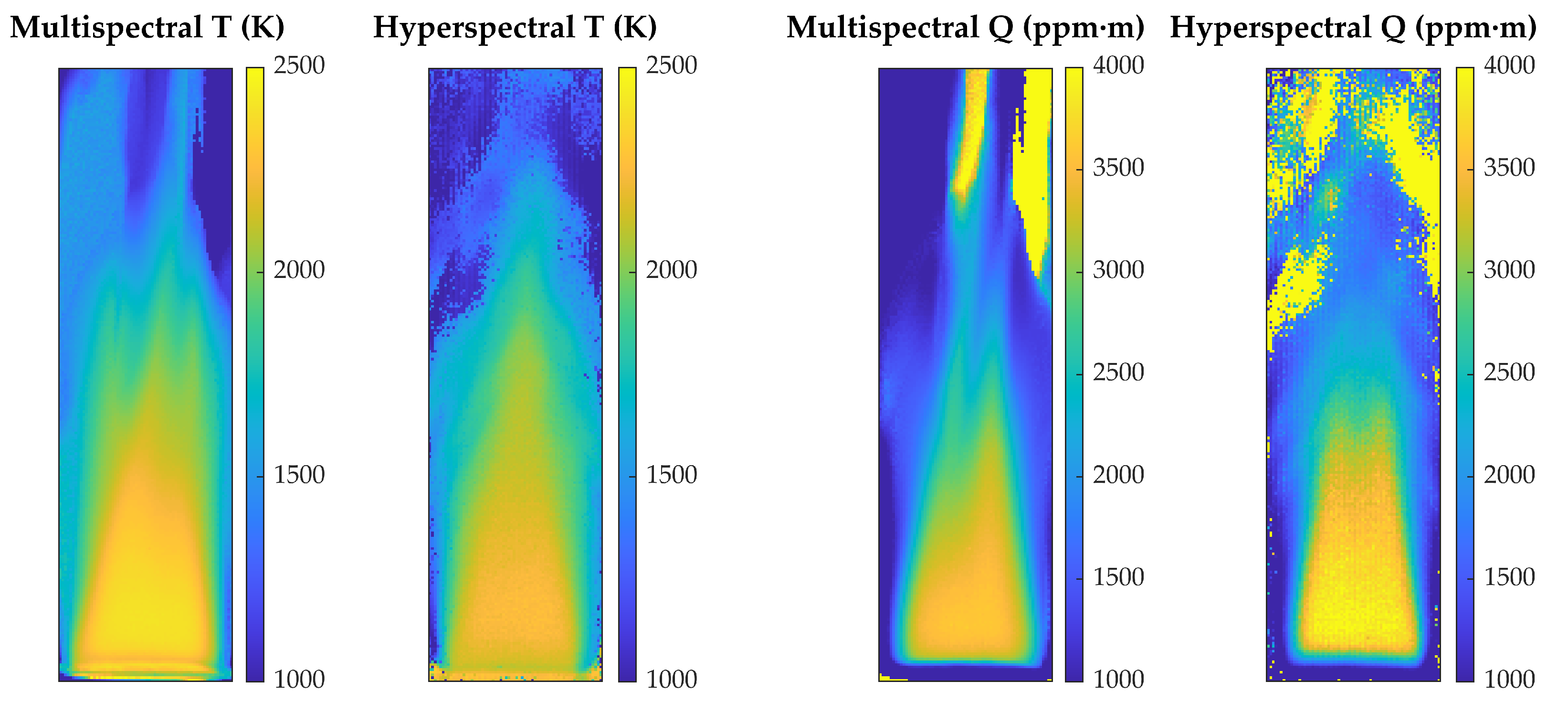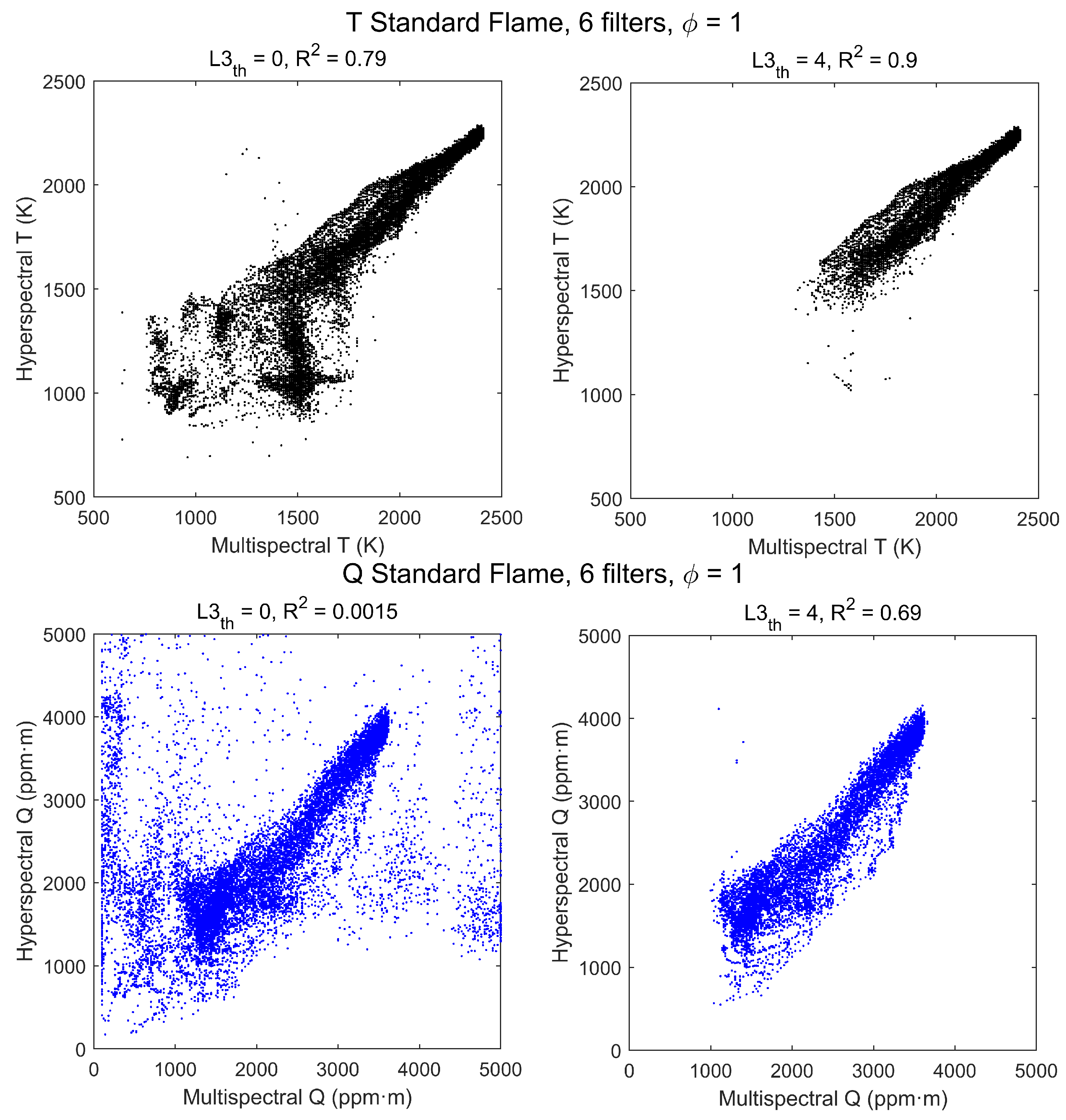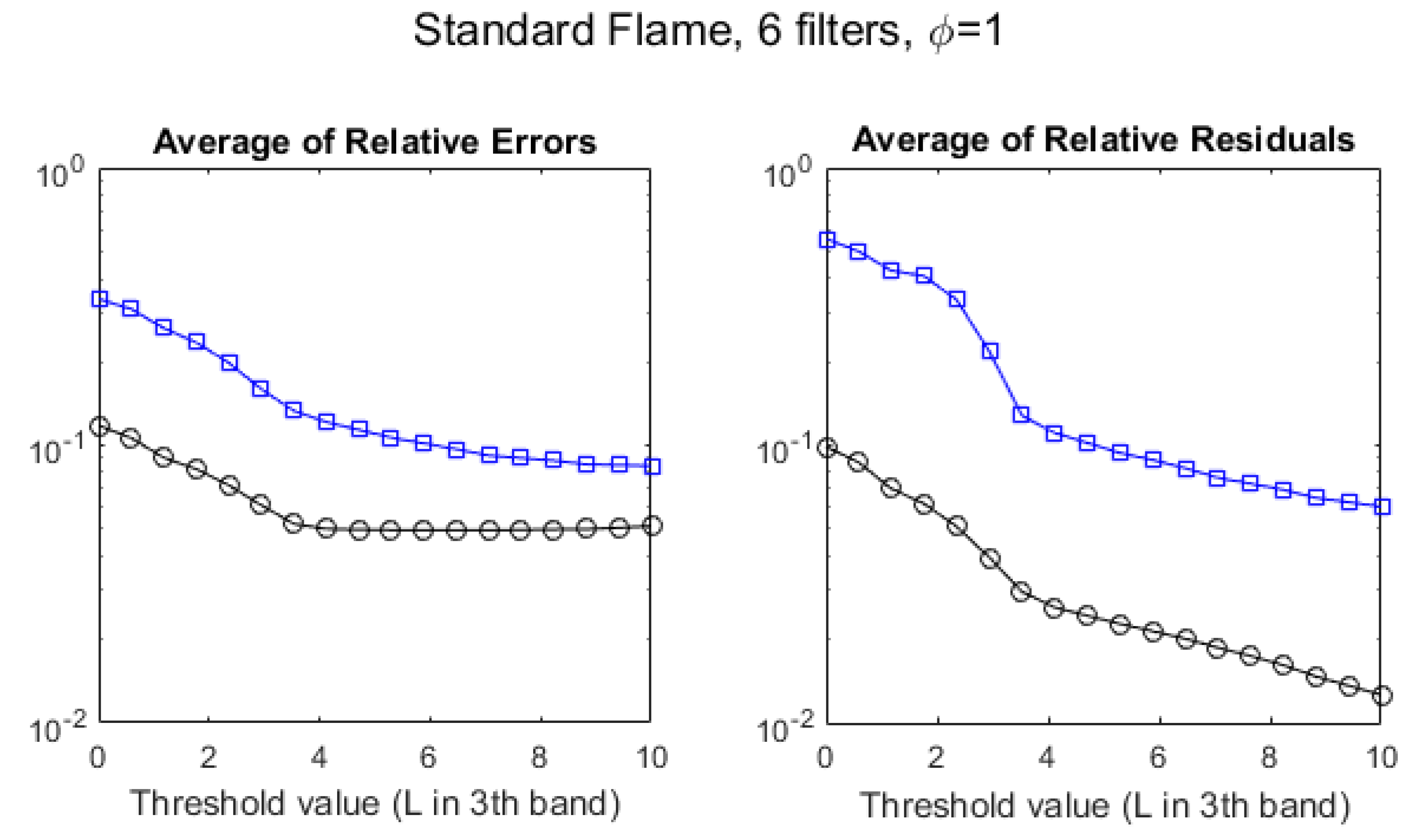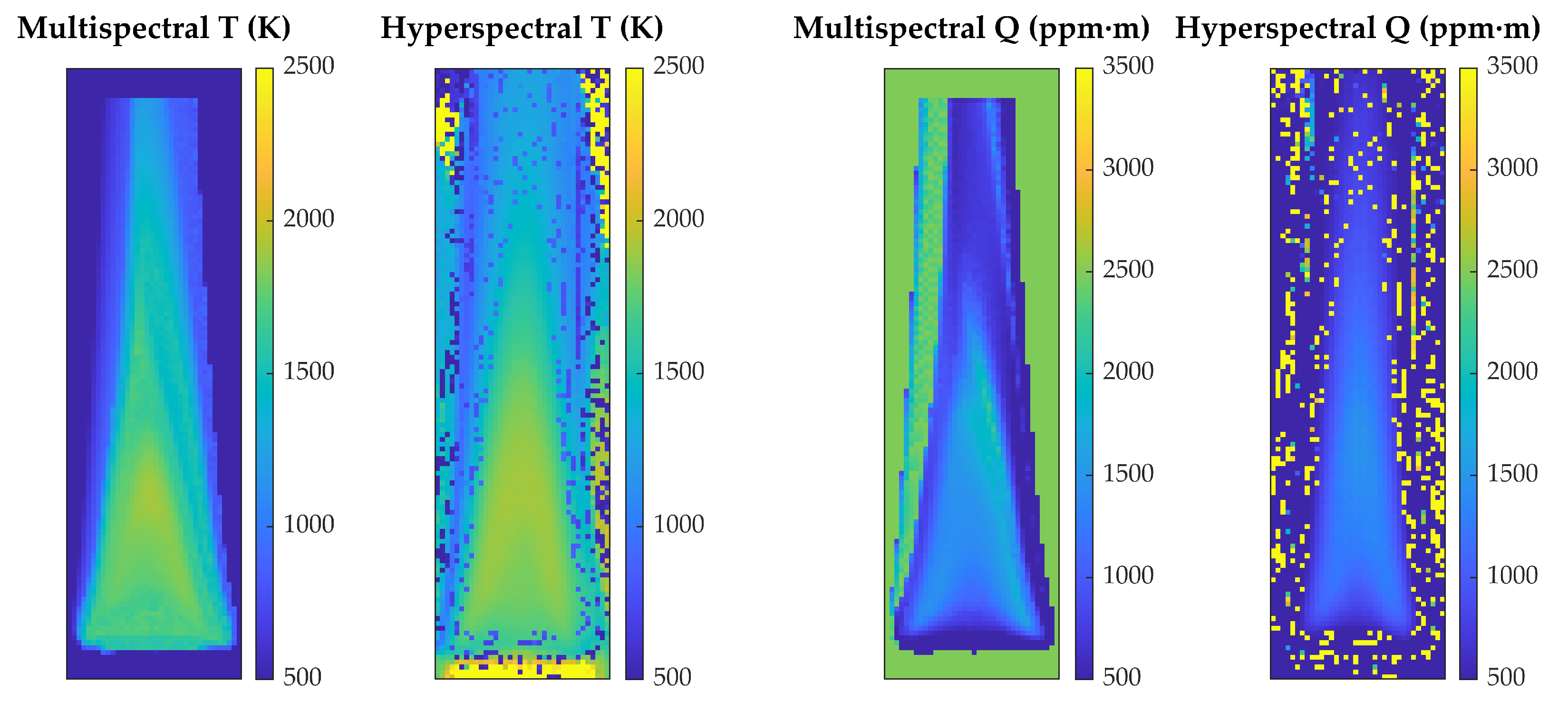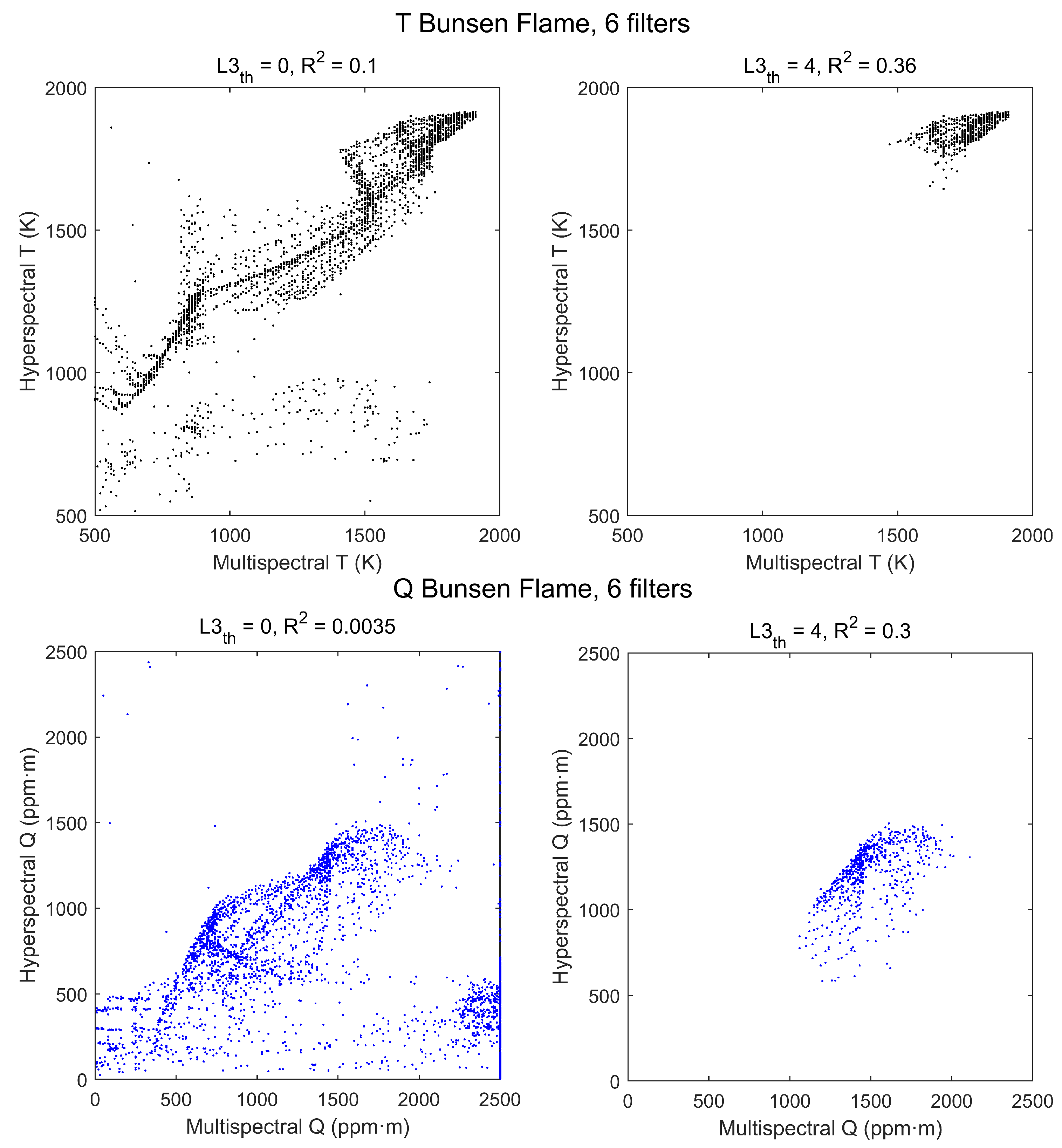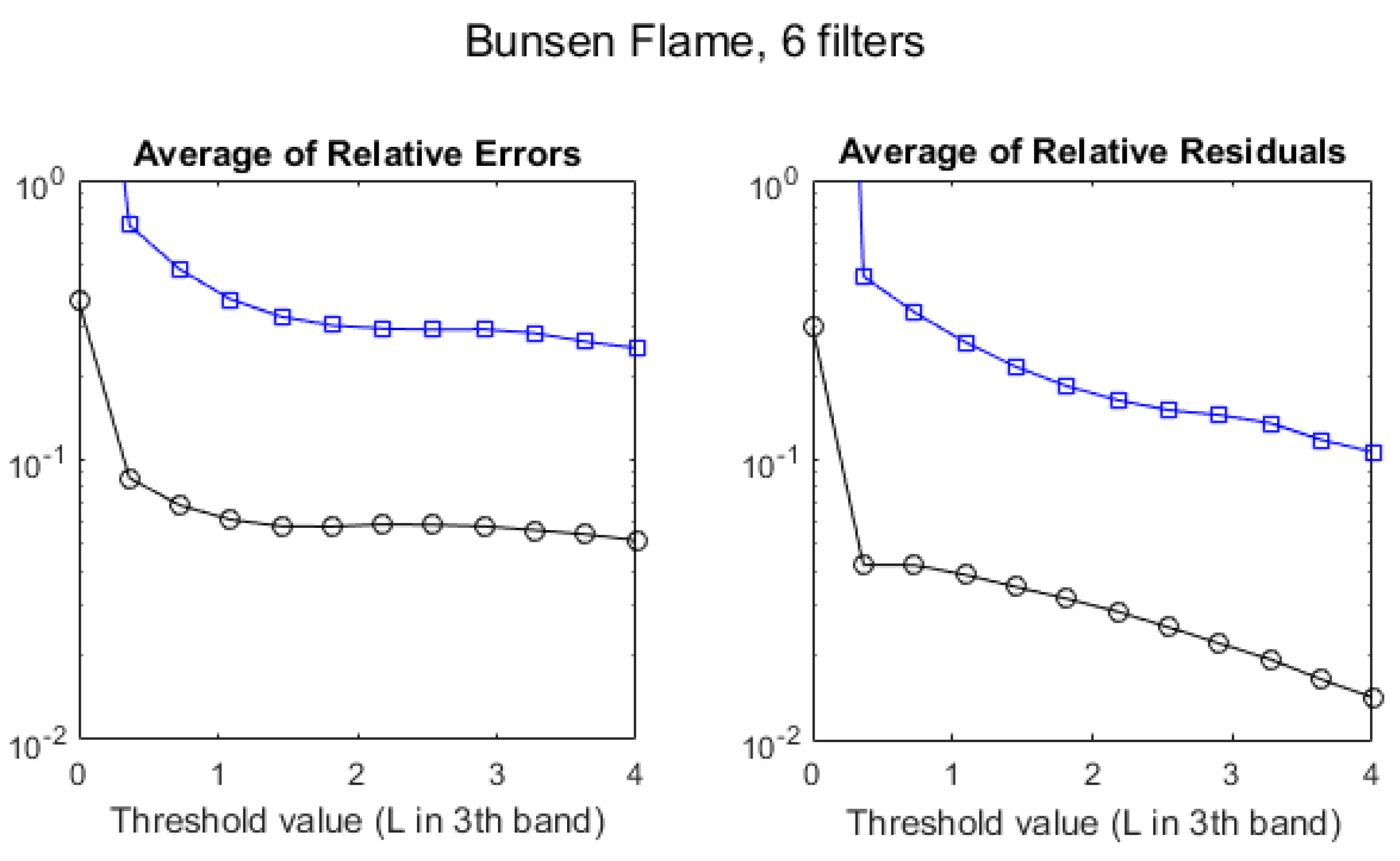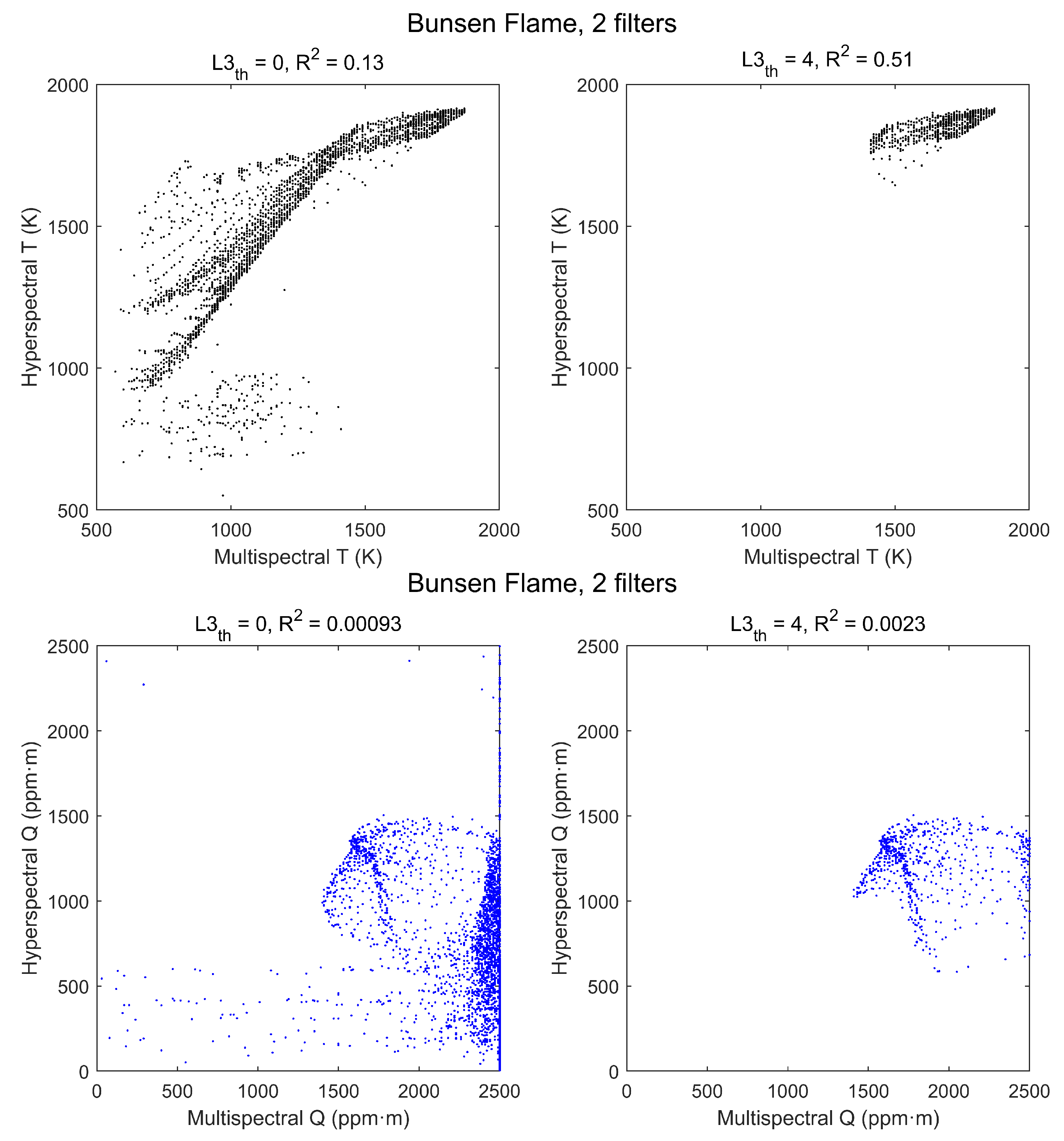1. Introduction
Combustion processes are of paramount importance in many economic sectors. Since temperature is the key factor that determines chemical reaction rates, an accurate control of it is essential to optimize these processes: monitoring of temperature improves consistency and energy efficiency in manufacturing, reduces wastage and pollution, increases reliability, and extends intervals of maintenance tasks. However, to measure physical parameters in a combustion process is a challenging problem, because intrusive probes can be damaged by the harsh environment, and even the toughest ones, such as thermocouples, induce perturbations in the flame, and provide readings with important systematic errors [
1]. Therefore, non-intrusive methods, in particular those of optical thermometry, have become the state-of-the-art.
Active laser-based techniques, such as CARS (Coherent Anti-Stokes Raman Spectroscopy) or LIGS (Laser Induced Grating Spectroscopy) require complex laboratory setups that are difficult to install and operate in industrial environments, but still have a relatively large uncertainty, generally not better than 5% [
2]. A promising alternative is passive techniques such as gas emission spectroscopy, whose setups are simpler since no excitation of the flame is required. In particular, the main chemical species in a flame have very specific emission profiles in the mid-IR band, that make possible their identification, quantization and, in principle, the measurement of their temperature.
One of the aims of the
European Metrology Programme for Innovation and Research (
EMPIR) project
EMPRESS [
2] (Enhancing process efficiency through improved temperature measurement) was to validate these spectroscopic techniques by measuring a standard flame of well-known temperature and chemical species concentration. The flame was developed by the British
National Physical Laboratory (NPL), and its temperature was measured by Rayleigh scattering thermometry (a technique traceable to the International Temperature Scale of 1990, ITS-90) at NPL, and by Fourier Transform Infrared (FTIR) emission spectroscopy by two research groups, one at the
Technical University of Denmark (DTU) and the other at
Carlos III University of Madrid (UC3M). It was found that the agreement between all measurements amounted to 1%, that is,
K for flame temperatures ∼2000 K [
3].
This is a very good result that demonstrates the accuracy of flame temperature measurement based on emission spectroscopy. The advent of portable Fourier-transform hyperspectral imagers in the mid-IR region (also called Imaging Fourier Transform Spectrometers, IFTS) makes it possible to apply this technique to obtain temperature maps of flames in-situ, without any ad-hoc setup, simply by acquiring and processing the spectral radiance emitted by the flame. An additional advantage of the method is that it provides also maps of concentrations for the main chemical species. Although, in contrast to temperature, we have no reliable independent measurements to compare with, results for the standard flame have shown an agreement with the calculations of the chemical equilibrium software
GasEq [
4] better than 15% for CO
and better than 10% for CO [
5].
However, hyperspectral imagers in the mid-IR are expensive, and data processing is complex and time-consuming. Practical application in industrial environments requires cheaper and simpler instrumentation and faster processing, even at the expense of a not-so-good accuracy. This target has been addressed in the second part of the referred
EMPIR project,
EMPRESS 2 [
6].
The basic approach is to use a mid-IR camera that becomes a multispectral instrument by using interference filters. In this low-cost instrument, the spectral radiance integrated over six bands provides the equivalent of a low-resolution emission spectrum of the flame, whose shape and intensity depend on the temperature T
and column density Q
(concentration × optical path) of the chemical species of the flame. Simulations of emission spectra for a whole range of values of temperature
and column density
are made using a line-by-line model that extracts the spectral parameters from the HITEMP2010 spectral database [
7]. These simulated spectra are then integrated over the spectral bands of the camera and the results are compared with the measured radiances in each pixel; the couple (T
, Q
), which gives the best agreement, provides the retrieved values of temperature and column density for the pixel.
This methodology overcomes the basic problem of thermography when applied to flames or, in general, gas plumes: the unknown emissivity of the target. This is also a problem in the thermography of solids, but it can be dealt with by assuming a smooth spectral dependence of emissivity, and using Bayesian or regularization methods to solve the coupling between temperature and emissivity effects in spectral radiance [
8,
9]. The spectral structure of gases, in contrast, is extremely complex, with thousands of discrete absorption-emission lines. For that reason, state-of-the-art flame pyrometry resorts to measuring soot emission, generally in at least two bands the visible range [
10]. This approach, however, is limited to sooty flames. In contrast, resorting to simulated spectra effectively parametrizes spectral emissivity as a function of T and Q, so that, if measurements are restricted to a spectral region where emission is due to a single chemical species (in our case, CO
), values of radiance in a few bands (in principle even two), could determine not only temperature, but also chemical composition, for any flame.
The feasibility of the multispectral method was demonstrated in a previous work [
11], where the uncertainty of this procedure was estimated theoretically by a Montecarlo method. It was found that, for the typical values of T and CO
in the standard flame, expected errors due to radiance fluctuations were very small:
K and
ppm
m. Errors for the first experimental results, however, were an order of magnitude larger, but no systematic analysis of the accuracy of the results was made, and only the standard flame in stoichiometric conditions was measured. In this paper, we present the full results achieved by the UC3M group within the
EMPRESS 2 project. The basic approach has been to study experimentally the accuracy of the results of the multispectral method by comparing them to those of the hyperspectral method in a variety of flames: the standard flame in stoichiometric, lean, and rich conditions, and an ordinary Bunsen flame. Since the hyperspectral method has demonstrated an excellent accuracy in the EMPRESS project, its results have been considered as a “ground truth” for temperatures, making it possible to calculate statistical benchmarks to qualitatively assess the accuracy of multispectral results. Column densities retrieved by both methods have been also compared, although in this case the accuracy of hyperspectral results has not been tested by independent measurements.
The effect of the number of filters has been studied, showing that temperature results with only two filters are nearly as good as those using six bands. The feasibility of bi-spectral measurement of flame temperatures opens the possibility of fast and cheap temperature imaging, with important industrial applications.
The structure of the paper is as follows.
Section 2 explains the radiative model used and the fundamentals and implementation of the two measurement methods employed—hyperspectral and multispectral.
Section 3 outlines the experimental setup and the instrumentation used, and
Section 4 describes the experimental results using six filters, comparing multispectral and hyperspectral T and Q values both for the standard flame and the Bunsen flame. Multispectral results obtained with a reduced number of filters are studied in
Section 5, showing that, even with only two filters, properly chosen, good results are achieved for temperature. Finally,
Section 6 summarizes the conclusions and suggests future work.
3. Experimental Setup and Instrumentation
The experimental setup is simply the practical realization of the scheme of
Figure 1, with a uniform low reflectance background at room temperature. Two different flames (the standard flame developed at NPL and an ordinary Bunsen flame) and two different imaging instruments (hyperspectral and multispectral) have been used.
The standard flame was developed by NPL in the framework of the EMPRESS [
3] project. The burner uses propane as fuel and produces a square array (40 × 40 mm) of small diffusion flamelets stabilized above it, with a zone of nearly uniform temperature and composition (
Figure 4). It can be set to different equivalence ratios, from
(lean flame) to
(rich flame). Temperature, species concentration, and flame dynamics vary with the equivalence ratio. The hottest and more stable flame is the stoichiometric (
), which has also a very small amount of CO [
3]. An additional feature of the standard flame is that the spatial profiles of temperature and species concentration are very flat, and therefore the assumption of uniform temperature and concentration along the line of sight is fully justified.
Measurements were also performed in a Bunsen burner using butane as fuel (model Labogaz 206 from Campingaz) to test the multispectral method in an ordinary flame similar to those used in many industrial applications. The equivalence ratio could not be measured, but the fuel inlet was regulated to obtain a flame approximately stoichiometric.
To ensure stability, both flames were turned on for one hour before the measurements were performed, and the doors and windows of the room remained closed throughout the process to keep temperature stable and to avoid drafts that could cause movements in the flame.
The IFTS used in this work is an FTIR hyperspectral Imaging System (Telops FIRST-MW) operating in the extended mid-infrared (MIR) region, from 1850 /
to 6600 /
. The system consists of a Michelson interferometer coupled to an InSb focal plane array (FPA), with 320 × 256 pixel resolution, an instantaneous (pixel) field of view of
, and a maximum resolution of
/
. In order to reduce the long acquisition time to ∼2 or 3 min, all spectra have been measured at
/
in a sub-window of 160 × 256 pixels. More information about this system can be found in [
12].
The IFTS was radiometrically calibrated at Centro Español de Metrología (CEM). Two blackbodies were used with an aperture large enough (70 mm diameter) to cover the whole field of view of the sub window used. Calibration temperatures were 180
C and 400
C. Since the spectral emission of the flame is concentrated in a narrow band in comparison to the full spectral range of the instrument, these blackbody temperatures were sufficient to calibrate the instrument for flame temperatures up to 2500
C [
3,
17].
On the other hand, the multispectral measurements were performed using a Thermosensorik SME 640 camera, that operates in the MIR band (3 to 5
m), with a 640 × 512 InSb Stirling-cooled FPA detector. It features a rotating wheel placed immediately after the optics, with a capacity for six interference filters of 1-inch diameter. The spectral transmittance profiles of the filters used are shown in
Figure 5, superimposed to a typical emission spectrum of the standard flame (in arbitrary units). For each filter, a different integration time was used in order not to saturate the camera response, and a radiometric calibration was performed with a 15 × 15 cm extended area blackbody radiator (model 4006 G from Santa Barbara Infrared, Inc., Santa Barbara, CA, USA) whose emissivity had been previously measured at Centro Español de Metrología (CEM).
In all multispectral measurements, the effect of atmospheric transmittance was taken into account using a standard atmospheric CO meter and calculating the corresponding value for the atmospheric path for calibration and for measurement. In hyperspectral measurements, the concentration of atmospheric CO was calculated by iterative fitting, with results in good agreement with those of the CO meter.
6. Summary, Conclusions & Future Work
Hyperspectral imaging in the mid-IR is capable of providing spatially resolved accurate measurements of flame temperature (T), as well as column densities (Q) for the main chemical species present, but it has the disadvantage of requiring expensive instrumentation and complex processing. In this work, these two problems have been approached by using a multispectral system built with a camera that operates in the mid-IR and has six channels defined by interference filters, and by proposing a fast method of retrieval of T and Q based on the pre-calculation of emission spectra, simulated line-by-line using the HITEMP2010 spectroscopic database, which are compared to the experimental multispectral measurements. This approach overcomes the difficulty that unknown emissivity poses to thermography of flames, because simulation of spectra effectively parametrizes the spectral emissivity of the flames as a function of T and Q.
The results have been systematically compared with those of the hyperspectral method for a standard flame of well-known composition and temperature, studied in previous works, and for an ordinary Bunsen flame. In each case, two benchmarks have been calculated to quantify the agreement of the multispectral temperatures and column densities with the hyperspectral values: the average of relative errors (ARE) and the average of relative residuals (ARR) of the values estimated by means of a linear regression.
The degree of agreement has been found to depend strongly on the level of radiometric signal of the flame, but for levels of radiance that correspond to T K in the standard flame, ARE in temperature is ∼5%, whereas the ARR is ∼2.5% and can be as low as nearly ∼1% for larger levels of radiance. Results in the Bunsen flame are comparable, although overall radiance levels are smaller, because maximum temperatures and, especially, column densities have lower values.
For all the cases studied it has been found that agreement with the hyperspectral results is much better for temperatures than for column densities. This is to be expected, since measurement in emission mode is always more sensitive to temperatures than to concentrations. An unexpected result, however, has been that the multispectral method has proven more robust than the hyperspectral method, with fewer pixels with obviously wrong values in the regions of low radiance levels.
One of the main findings of this work is that values of T retrieved with only four, or even two filters, are nearly as accurate as those obtained with the full multispectral information of the six filters. Values of Q, on the other hand, are not affected by using four filters instead of six, but are clearly worse when using only two. The feasibility of accurate bi-spectral thermometry in flames is a very promising result, because a bi-spectral system could be implemented without the need for moving parts using two detectors with independent optics, or possibly dual-band detectors. The ability to measure temperature and CO column density with only two spectral channels opens also the possibility to use other channels to measure other chemical species; in particular, CO and unburned hydrocarbons, which have emission lines in the mid-IR. This can be very useful to estimate combustion efficiency, a critical parameter in many industrial applications.
A critical factor that has limited the performance of both the multispectral and the hyperspectral methods has been flame stability, in particular for the less energetic regions, that are also more easily affected by air drafts. The regular flame flickering can be dealt with, thanks to the specific processing developed in [
16], but since hyperspectral measurements take typically a few minutes, it is essential that the flame does not change its dynamics during that period of time. An advantage of multispectral measurements is that they can be much faster, but in our case they have taken a similar time because the filter wheel position and the integration time were changed manually. There is thus room for improvement by automating this process; this could reduce the measurement time to ∼1 s or even less and would increase accuracy for regions outside the flame core.
